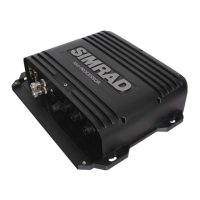48 |
Radar | NSO-II Operator Manual
Optimizing the radar image
You may be able to improve the radar image
by adjusting the radar sensitivity, and by
ltering out the random echoes from sea and
weather conditions.
You select between the control images by
tapping the image or by pressing the OP40
rotary knob. Active control will expand and
display its name in full. You can then adjust
the value by turning the OP40 knob or by a
vertical dragging movement on the control
you want to adjust.
Gain
The gain controls the sensitivity of the radar receiver.
A higher gain makes the radar more sensitive to radar returns, allowing it to display
weaker targets. If the gain is set too high, the image might be cluttered with background
noise.
Gain has a manual and an automatic mode. You cycle through the modes by pressing
and holding the OP40 rotary knob. You can only adjust the gain value in manual mode by
turning the OP40 rotary knob or a vertical dragging movement over the gain control.
Sea clutter
Sea clutter is used to lter the eect of random echo returns from waves or rough water
near the vessel.
When you increase Sea Clutter ltering the on-screen clutter caused by the echoes of
waves will be reduced.
A long-press on the OP40 rotary knob will cycle through available Sea clutter modes. You
can only adjust the sea clutter value in manual mode by turning the OP40 rotary knob or a
vertical dragging movement over the sea clutter control.
Rain Clutter
The Rain clutter is used to reduce the eect of rain, snow or other weather conditions on
the radar image.
Adjust value by turning the OP40 rotary knob or a vertical dragging movement over the
rain clutter control.
The value should not be increased too much as this may lter out real targets.
Rejecting radar interference
Interference could be caused by radar signals from other radar units operating in the
same frequency band.
A high setting will reduce the interference from other radars.
In order to not miss weak targets, the interference rejection should be set low when no
interference exists.
Positioning the radar center
You can move the radar PPI center to dierent positions within the radar panel, and select
how your vessel symbol moves on the radar image.
Radar motion is indicated on the upper left corner of the radar panel as either
TM (True motion) or RM (Relative motion).
The radar position can only be changed when the radar is transmitting.
Center
Default setting. The radar PPI center is centered on the radar panel.

